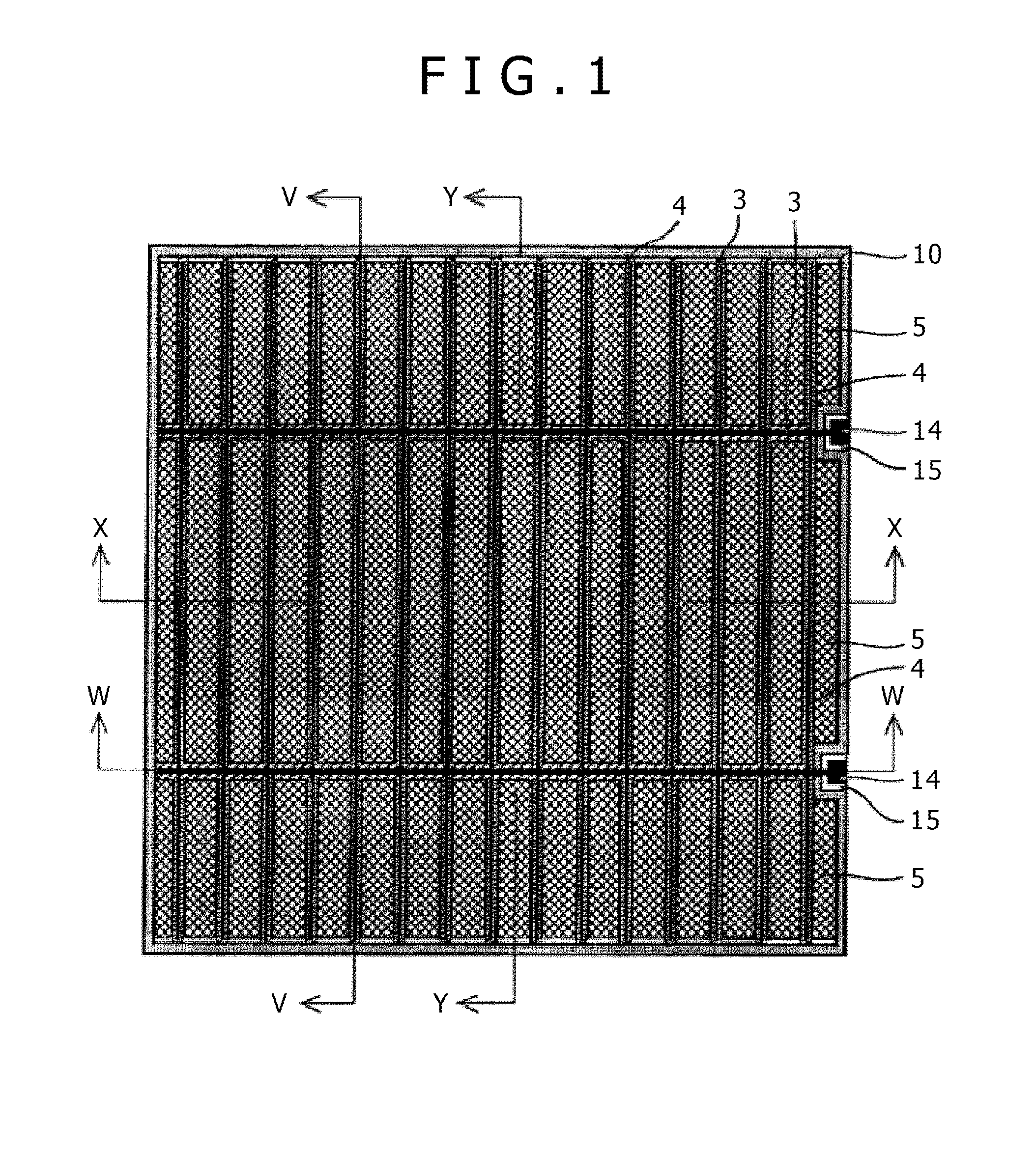Photoelectric conversion device and photoelectric conversion device module
a conversion device and photoelectric technology, applied in the direction of pv power plants, sustainable manufacturing/processing, final product manufacturing, etc., can solve the problems increasing the difficulty of avoiding the lowering of the conversion efficiency accompanying the area increase, and increasing the difficulty of effectively collecting electrons arising from photoelectric conversion by the photoelectric conversion layer. , to achieve the effect of increasing the thickness of the collector layer, improving the current collection efficiency, and simple structur
- Summary
- Abstract
- Description
- Claims
- Application Information
AI Technical Summary
Benefits of technology
Problems solved by technology
Method used
Image
Examples
embodiment
Opposed Cell
[0047]FIG. 1 is a plan view for explaining the configuration of a dye-sensitized solar cell (opposed cell) in the embodiment of the present invention.
[0048]FIGS. 2A to 2D are sectional views for explaining the configuration of the dye-sensitized solar cell (opposed cell) in the embodiment of the present invention.
[0049]FIG. 2A is a sectional view along line X-X shown in FIG. 1 (X-X sectional view). FIG. 2B is a sectional view along line Y-Y shown in FIG. 1 (Y-Y sectional view). FIG. 2C is a sectional view along line W-W shown in FIG. 1 (W-W sectional view). FIG. 2D is a sectional view along line V-V shown in FIG. 1 (V-V sectional view).
[0050]As shown in FIG. 1 and FIGS. 2A to 2D, the opposed cell is composed of a window electrode (working electrode) on which light is incident, a counter electrode disposed opposed to the window electrode, and an electrolyte layer 6 disposed between the window electrode (working electrode) and the counter electrode. The window electrode (w...
working example
Example of Layer Configuration of Opposed Cell
[0115]Specific examples of the respective layers configuring the opposed cell shown in FIG. 1 to FIG. 3B will be described below.
[0116]FIG. 8 is a diagram for explaining the pattern of the porous photoelectric conversion layer (porous oxide semiconductor layer, TiO2 electrode) 5 in a working example of the present invention.
[0117]As shown in FIG. 8, the pattern of the porous photoelectric conversion layer 5 is formed with a thickness of 20 μm on a surface of the transparent substrate (transparent glass substrate (FTO glass substrate on which FTO is formed)) 1. The pattern is composed of sixteen columns and three rows of the porous photoelectric conversion layer 5 having a pattern of strips of 2.95 mm×23 mm, 2.95 mm×46 mm, 2.95 mm×19.5 mm, 2.95 mm×39 mm, 5.9 mm×23 mm, and 5.9 mm×46 mm.
[0118]FIG. 9 is a diagram for explaining the pattern of the catalyst layer (carbon electrode) in the working example of the present invention.
[0119]As shown...
PUM
 Login to View More
Login to View More Abstract
Description
Claims
Application Information
 Login to View More
Login to View More - R&D
- Intellectual Property
- Life Sciences
- Materials
- Tech Scout
- Unparalleled Data Quality
- Higher Quality Content
- 60% Fewer Hallucinations
Browse by: Latest US Patents, China's latest patents, Technical Efficacy Thesaurus, Application Domain, Technology Topic, Popular Technical Reports.
© 2025 PatSnap. All rights reserved.Legal|Privacy policy|Modern Slavery Act Transparency Statement|Sitemap|About US| Contact US: help@patsnap.com



